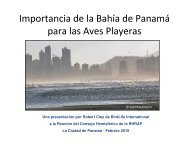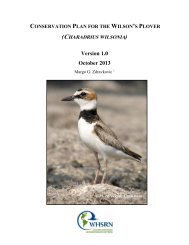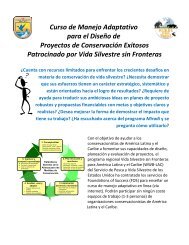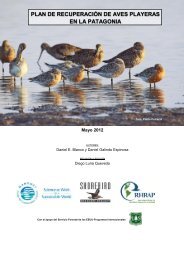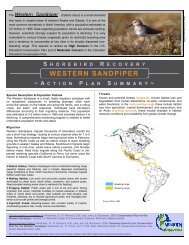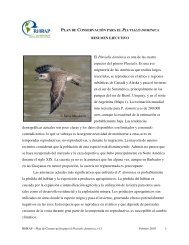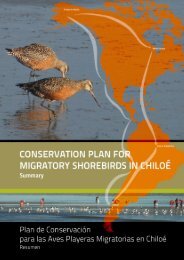Sanderling Plan - Western Hemisphere Shorebird Reserve Network
Sanderling Plan - Western Hemisphere Shorebird Reserve Network
Sanderling Plan - Western Hemisphere Shorebird Reserve Network
Create successful ePaper yourself
Turn your PDF publications into a flip-book with our unique Google optimized e-Paper software.
VARIABILITY AND UNCERTAINTY<br />
Several large-scale questions are important from both a conservation and ecological<br />
perspective: What is the overall stability and predictability of the systems in which the<br />
<strong>Sanderling</strong> occurs (change in landscape, change in predation, change in food resource, change in<br />
climate)? How variable are the environmental conditions faced by <strong>Sanderling</strong>s through time<br />
(seasons, years) and space (across sites, states, continents, hemispheres)? How do <strong>Sanderling</strong>s<br />
respond to environmental uncertainty? And, are there predictable strategies?<br />
MANAGEMENT-RELATED NEEDS<br />
The primary management considerations for <strong>Sanderling</strong>s are to provide enough habitats<br />
with enough food and safety at each location. Specific research needs related to management<br />
include those mentioned above, as well as some related to the timing of management actions:<br />
o Determine lengths of stay (turnover rates) at stopover sites to help target management<br />
actions;<br />
o What factors affect length of stay? And, can management alter this beneficially?<br />
o Identify factors that may limit the quality of stopover habitats. For instance, if sand is to<br />
be extracted (e.g., in Washington state), or deposited (e.g., beach nourishment), is there a<br />
season when these actions can be done with minimal impact (i.e., summer?) Or perhaps,<br />
might the size and spacing of extraction/deposition areas be evaluated prior to<br />
manipulation?<br />
ENERGETICS<br />
Given the energetic requirements for an itinerant lifestyle (i.e., completing spectacular<br />
migrations twice a year), it is crucial that <strong>Sanderling</strong>s have an adequate food supply at migration<br />
stopover sites, with adequate roosts (for resting), and safety from disturbances and dangers<br />
(predation, pollution, excessive/chronic human disturbance). Research is needed to estimate the<br />
amount of food/roost resources needed for a <strong>Sanderling</strong> to build up fat, under different scenarios<br />
(i.e., with and without disturbance). The amount of fat can be converted into estimates of the<br />
distances a bird can fly—and therefore can provide insights into the food resources and habitat<br />
needs of the species at stopover sites.<br />
WHSRN – <strong>Sanderling</strong> Conservation <strong>Plan</strong>, February 2010, v1.1 64




